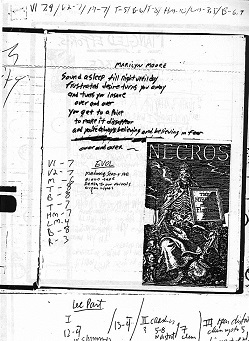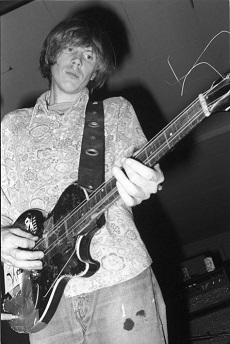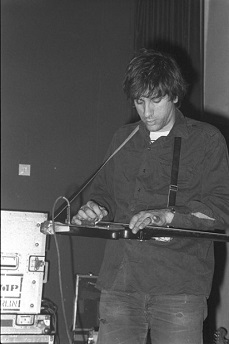
Following the smash success of "Death Valley '69", Sonic Youth once again joined forces with Lydia Lunch to take the charts by storm. Unfortunately, the song they wrote was "Marilyn Moore". Just kidding - I didn't know how to start - but our song of the week was another collaboration with Lydia. This time, she wrote a verse but did not contribute any vocals, with Thurston singing both his and Lydia's words. A page from Thurston's lyric journals containing his half of the song was originally published in Alec Foege's Confusion is Next biography, and later reprinted in the ineffable Sonic Matters, Sonic Kollaborations book that accompanied a 2000 exhibition of the band's art and ephemera. Pages from these same journals appear in the Bad Moon Rising CD liners, often adorned with tuning notes or amp settings or stickers. Over the years, I've come to accept some of these as red herrings, and the "Marilyn Moore" lyric sheet has always been particularly intriguing. You can see the book itself defined within the xerox, and then it looks like the amp settings at the top and the "Lee part" notes at the bottom are written outside of the pages. If I had to guess, Lee would take a photocopy of Thurston's notes and then fill in his own details in the free space. That's just a theory though, and I'm honestly not 100% sure that the "Lee part" notes even apply to "Marilyn Moore".

I'm getting ahead of myself, though. Below the lyrics, you can see a rough list of songs for EVOL developing, including "Madonna, Sean + Me" (aka "Expressway"), "Piano Tape" (presumably "Secret Girl"), "Death to our Friends", and "Green Lights". Three of these began appearing in live sets throughout 1985, once Steve had joined the band. "Death to our Friends" was the odd one out, not known to be played live until April 1986, having already been recorded for EVOL. Regardless, it seems to have been the fourth song properly considered for the project, and might pre-date everything else (perhaps it was played at the January 1986 Irving Plaza gig?). Most of the album was written quickly in early '86 before they returned to Martin Bisi's studio, where they'd previously recorded Bad Moon Rising.
Of all the songs the band cooked up for EVOL, "Marilyn Moore" is one of the most peculiar, particularly due to the instruments used and approach taken to squeezing sound from them. Lee would hold his Kent Polaris guitar flat, perpendicular to his body, and use a slide like a lap steel (with no lap). He chose a unique tuning that required raising the low E all the way up to C: CCD#GGD. Not to be outdone, Thurston devised an even stranger part on a stranger guitar: his infamous Drifter (last seen causing drama with a cowbell in the Early Sonic piece). I'm not 100% sure what the Drifter was used for between 1983 and 1986, if anything, but it received a bit of a makeover: they removed its frets and restrung it with four bass strings (basically occupying the EA and BE strings, leaving the DG in the middle empty). He tuned the bottom 2 strings to C - same octave as Lee's - and tuned the top pair to D#. However, these aren't in unison - one string matches the 3rd fret of the C strings, one string is tuned an octave lower. So, his tuning is basically CCD#D# with the D# strings an octave apart. Not particularly designed for fretting notes, he spends most of the song playing sharp harmonics up and down the strings.
When the band flew to Texas in April '86 to play two shows, they premiered all of the remaining EVOL material except for "Marilyn Moore" (and the unreplicable "In the Kingdom #19"). Chances are they didn't want to bring two extra guitars just to play one song (I think they even borrowed an instrument or two once there, not that you could reasonably Drifterize a guitar on loan). Instead, the song was premiered on May 5th, 1986 - the first date of the European EVOL tour. The song was often, but not always, the opener for this tour and the North American leg that followed, but it also popped up mid-set or in encores. Curiously, it vanishes from set lists after July 7th in San Francisco (noteworthy for being the show where Lee's other Kent guitar broke onstage, leaving him in need of a new GDD# vehicle - and while the timing seems right, I don't think the Polaris would suffice). It's possible one of the "Marilyn Moore" guitars also had technical issues, or they just didn't feel like playing it after "Tom Violence" usurped the opening spot. They did encore with "Marilyn Moore" on July 21st in Cleveland, before it disappeared again, suggesting that they maybe just tired of playing it? (Thurston's intro: "This is a love song for an old high school teacher of mine. Her name is Marilyn Moore." In Goodbye 20th Century, it's suggested that Thurston was imagining Marilyn Monroe as his own sister.)
They had one more tour left in 1986, the "Flaming Telepaths" tour with fIREHOSE (named after a Blue Oyster Cult tune, the tour's most memorable moments were the "everybody onstage" encores of "Star Power" and "The Red and the Black", another BOC song). After a rare 1986 performance of "Halloween" to open the show on Halloween, "Marilyn Moore" returned to the opening slot on November 2nd and stayed there until at least November 22nd, if not the final date of the tour (which has not surfaced). Along with "Star Power" and "Death to our Friends", this would be its last performance. However, when looking to pad out the Sister set list in Europe the following summer, the band rehearsed both "Green Light" and "Marilyn Moore" - available recordings from 1987 suggest that only "Green Light" made the cut. Truthfully, I'm surprised they'd consider "Marilyn Moore" of all songs - given it required two instruments that were otherwise not used, and was not quite the same pace as the Sister material which mostly comprised the set.


So, let's go back to the song itself, particularly the EVOL recording. Curiously, it begins with a rather high fidelity sample of the infamous "Scream tape", which was typically heard blaring between songs on stage. Thurston and Lee had recorded themselves screaming in a large silo in Switzerland during the band's first visit to Europe in June 1983, and instantly began incorporating the tape into their live set. The echoed screams introduce "Marilyn Moore" while Lee softly picks out his open strings, before starting a simple shrieking slide pattern. Thurston responds by picking aggressively jagged harmonics up and down his C strings, then Kim and Steve lock into a plodding tom-heavy groove. Thurston delivers a slow, droning verse, pausing for a brief interlude - during live versions, he would start playing a specific four-note trem picked pattern for the second half of his verse. His part on the album is much more obscured, not just by his playing but also the heavy reverb and enthusiastic panning. At the end of his verse, Kim hangs on a single note, and they take a long breath before the final verse, which was written by Lydia Lunch. This is a classic Sonic Youth structure, having Steve and Kim hold down the backbone, leaving Thurston and Lee to their own brand of less defined chaos - indeed, Lee's slide part on the record is merely a guide for the lengths he'd go live, and Thurston didn't even seem to have his part fully worked out when they cut the EVOL take.
This is why live versions are always key! Unfortunately, the Denver show released from the North American EVOL tour was taken from the leg where "Marilyn Moore" had been temporarily shelved, but two live versions did see very limited release. One from May 29th in Wiesband, Germany was included on an extremely rare cassette compilation titled River of No Return (the song is actually listed as "Tom Violence" in the accompanying booklet). The other was from June 19th in Washington, DC, and originally appeared on a 7" that came with issue #4 of Chemical Imbalance. This version was later collected on Rarities 2. I'd also encourage you to check out a video of the song - fortunately, there are a handful of 1986 videos readily available, which is more than I could say for VHS trading at the turn of the century (at least in my experience). The Atlanta gig from the summer leg is a revelation, as is St Louis from the Flaming Telepaths tour in the fall. Not to mention all of the EVOL tourfilm leaks...
When I originally tried to work out what was going on in this song decades ago, I just had one grainy, generated video from May 1986 to go on (misidentified for years as May 16th in Edinburgh, but really filmed May 18th in Glasgow). It was a washed out smear of a show, but the only performance footage I could find for some of these songs. I could tell that Lee was holding his guitar "up", and in a flash of light I could identify the shape of the pickguard enough to link it to the Polaris, which appeared in photos from that era (it also later toured with the Sensational Fix exhibit among other classic SY guitars). Trying to make out what guitar Thurston was playing was impossible, and my best guess at his tuning was something like GGCCD#D# (Lee's was easier since he deliberately picks the open strings out multiple times). It wasn't until much later, that I saw another video from 1986, where Thurston was more visible, and realized he was playing the Drifter. It became a slow process of putting pieces together (for a while I still thought it had six strings), before I had the situation deciphered. His part is still a bit of a mystery to me, I think if you scope out a live version with good separation you can pin down his patterns easier than on the record, where everything kinda blends.
Regarding Lee's part, once you have a rough idea of how to play it, I encourage you to go back and look at that lyric sheet with all of those notes, in particular "Lee's part" on the bottom. Can you make that make sense with what we hear on "Marilyn Moore"? I suppose it could just be an earlier arrangement/idea, but aside from beginning on the 12th fret, I can't really follow. He writes "w/ shimmer" - is that shaking the slide? Sounds more like a chorus effect to me, and he notes "distort" and "clean" at points - while "Marilyn Moore" has its clean moments, he is generally arpeggiating the open strings, not playing the 7th fret. Even the three segments seem undefined to me, though I suppose verse/middle/verse would be the division. "hi up + end slide" could be applicable, but I don't know. Any ideas? Do you like this song? I feel like it's definitely a deep cut, but worth revisiting if you haven't heard it in a while. Please contact me with any comments or corrections, and hold on to your Drifters - you'll need them next time!
"MARILYN MOORE"
LAYOUT
A - B - C - D - E
KIM
EADG
CENTER
THURSTON
CCD#D#
RIGHT
LEE
CCD#GGD
LEFT
A SECTION 00:00-00:19
Thurston does not play during the intro.
Lee arpeggiates his open strings over and over:
D-------------0---
G-----------0-----
G---------0-------
D#------0---------
C-----0-----------
C---0-------------
Kim does not play during the intro.
The "Scream tape" from June 1983 is also heard during the intro. It was previously released
on a Tellus compilation and often used on stage to segue between songs.
B SECTION 00:19-01:28
Thurston trem picks the C strings while running harmonics up and down:
D#---------------
D#---------------
x----------------
x----------------
C---*5*////*1*---
C---*5*////*1*--- rapidly pick harmonics from 5th fret down to 1st fret
Lee holds his guitar flat and uses a slide - he repeats the same motif over and over
but is not always 100% precise with the timing/intonation. He shakes the slide over
the fret while playing it for an vibrato type effect.
D--------------------
G---12\\15///12~~~---
G---12\\15///12~~~--- w/ slide
D#--12\\15///12~~~---
C---12\\15///12~~~---
C---12\\15///12~~~---
Kim comes in at 0:39 playing this:
G-----------------0-0-0-0-0---
D---\10---13/-10-------------- the slides are very subtle - slide into the 10th fret quickly
A----------------------------- hold 13 and slide back to 10
E-----------------------------
C SECTION 01:28-02:09
Thurston starts this section with the same harmonic picking, then quickly switches to
droning the C strings. The guitars start to get stitched together in the mix, but if you
listen to live versions he starts playing a four-note progression after the first half
of this verse, and continues it through til the D section:
D#--0---------7--------- the 3rd note is played only on the LOW D# string
D#--0---------/---------
x---/----/----/----/----
x---/----/---------/----
C--------0---------7----
C--------0---------7----
Lee keeps playing a similar motif, but the mix on the album gets a little crossed at
this point. During live versions, he'd go up to the 19th fret when Thurston sings
"believing in fear":
D-------------------- -----------/19~~~---
G---12\15~~~/12~~~--- ---12\15~~~/19~~~---
G---12\15~~~/12~~~--- ---12\15~~~/19~~~---
D#--12\15~~~/12~~~--- ---12\15~~~---------
C---12\15~~~/12~~~--- ---12\15~~~---------
C---12\15~~~/12~~~--- ---12\15~~~---------
He basically goes from the 12th/15th fret up to the 19th, and back down again. It's
easier to follow on live versions.
Kim continues the same riff.
D SECTION 02:09-03:03
Thurston drones the higher D# for a bit:
D#------ ------- ----------
D#--0--- ------- ----------
x---/--- ------- ----------
x------- ------- ----------
C------- at 2:25: ---0--- then: ---*12*--- trem picking all
C------- ---0--- ---*12*---
Then start playing a similar sliding harmonic riff like the first verse:
D#---------------
D#---------------
x----------------
x----------------
C---*5*////*1*---
C---*5*////*1*--- rapidly pick harmonics from 5th fret down to 1st fret
You can also start from the 12th fret and go back to the 5th and up again.
Lee does an aggressive slide up to 19th fret right at 2:09, then goes clean
and starts running the slide back down the neck slowly while picking:
2:20
D---19~~--------------
G---19~~~\\\\\\17~~~--
G---19~~~\\\\\\17~~~-- move slide between 17 and 19 while picking
D#--19~~~\\\\\\17~~~--
C--------------17~~~--
C---------------------
Then down around the 15th fret at 2:42
D-------- -------------
G---15--- -------------
G---15--- keep rubbing around there, -------14---- pick @ 14, down to 13-ish
D#--15--- move to 14th fret around 2:50 -------------
C---15--- ---14--------
C---15--- -------------
Then settle at 12th fret for the next section.
Kim changes her riff right when Thurston sings "over again...", holding the D#:
G------0-0-0----0-0-0----0-0-0-0-0--- she plays the open G string while holding the D# note
D---13-------13-------13-------------
A------------------------------------
E------------------------------------
E SECTION 03:03-04:04
Thurston keeps doing the sliding harmonic motif at the start of this verse. At 3:15 he settles in
on the 7th fret:
D#--------
D#--------
x---------
x---------
C---*7*--- trem pick / some open C can bleed in
C---*7*---
At 3:28 he plays a new harmonic pattern:
D#--*12*-*12*-*12*-*12*-*12*-*12*-*12*-*12*-------------------------------------------
D#--*12*-*12*-*12*-*12*-*12*-*12*-*12*-*12*-------------------------------------------
x-------------------------------------------------------------------------------------
x-------------------------------------------------------------------------------------
C-------------------------------------------*12*-*12*-*12*-*12*-*12*-*12*-*12*-*12*---
C-------------------------------------------*12*-*12*-*12*-*12*-*12*-*12*-*12*-*12*---
D#--*7*-*7*-*7*-*7*-*7*-*7*-*7*-*7*-----------------------------------
D#--*7*-*7*-*7*-*7*-*7*-*7*-*7*-*7*-----------------------------------
x---------------------------------------------------------------------
x---------------------------------------------------------------------
C-----------------------------------*7*-*7*-*7*-*7*-*7*-*7*-*7*-*7*---
C-----------------------------------*7*-*7*-*7*-*7*-*7*-*7*-*7*-*7*---
Play whole progression twice. Then at 3:44, he bashes out 5 open C notes:
D#------
D#------
x-------
x-------
C---0--- or 12th fret harmonix
C---0---
Lee starts picking out a shaky 2-note motif while rubbing the slide around the 12th fret,
before going up to the 19th fret:
3:03 3:17
D----------------19~~-------
G---12~~---------19~~-------
G---12~~---------19~-------- for the 12th fret, Lee will go up or down slightly while picking
D#--12~~-------------------- (13th or 11th fret)
C---------------------------
C---------------------------
At 3:27 he ditches the slide and begins arpeggiating the open strings like the intro, and then
strumming them a few times towards the very end.
Kim keeps playing the D# / open G figure til the end.
text + tab by Chris Lawrence
Return to the Sonic Youth Guitar/Bass Tab Archive